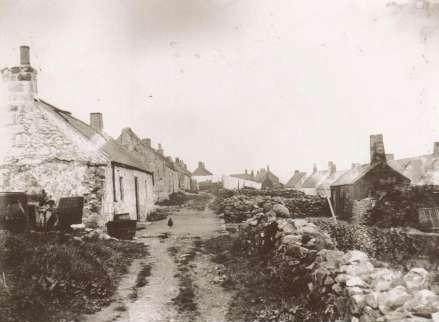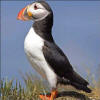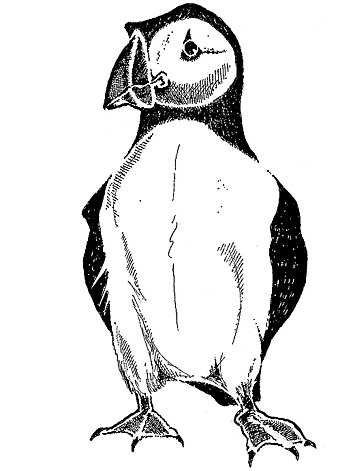
Puffin |
Awww, a Sea Parrot, arenít they cute! The Puffin is an unmistakable seabird with its black back and white under parts, distinctive black head with large pale cheeks and a tall, flattened, brightly-coloured bill. Its comical appearance is heightened by its red and black eye-markings and bright orange legs. There are four different types of Puffin, a member of the Auk family, and the one that is familiar to us is the Atlantic Puffin.
 The
Puffin must be one of the most popular birds in the world and we are
lucky to have them breeding on our coast. We donít have huge colonies
but there are small pockets of them throughout the area. Iím lucky that
I can observe them almost daily during the summer as they nest at the
ďKnaps of DowniesĒ which is right next to where I have some of my
lobster creels in the water. On some evenings itís possible
to count over 20 individuals standing guard over a nest site and watch
others taking off and landing at regular intervals.
The
Puffin must be one of the most popular birds in the world and we are
lucky to have them breeding on our coast. We donít have huge colonies
but there are small pockets of them throughout the area. Iím lucky that
I can observe them almost daily during the summer as they nest at the
ďKnaps of DowniesĒ which is right next to where I have some of my
lobster creels in the water. On some evenings itís possible
to count over 20 individuals standing guard over a nest site and watch
others taking off and landing at regular intervals.
 Puffins
will form a long term bond with a partner and will mate for life. They
are colonial nesters, using burrows on grassy cliffs although they will
also nest amongst rocks and scree. Male puffins perform most of the work
of clearing out the nest area, which is sometimes lined with grass,
feathers or seaweed. The only time spent on land is to nest, and mates
are found prior to arriving at the colonies. The Puffin will lay a
single egg which is creamy white in colour.
Puffins
will form a long term bond with a partner and will mate for life. They
are colonial nesters, using burrows on grassy cliffs although they will
also nest amongst rocks and scree. Male puffins perform most of the work
of clearing out the nest area, which is sometimes lined with grass,
feathers or seaweed. The only time spent on land is to nest, and mates
are found prior to arriving at the colonies. The Puffin will lay a
single egg which is creamy white in colour.
Feeding areas are often located more than 50 miles offshore from the nest, though during breeding season the birds are likely to venture out only half that distance. Puffins can dive for distances of up to 200 feet and are propelled by their powerful wings, which are adapted for swimming and their webbed feet act as a rudder while submerged. They collect several small fish, such as herring, sprats and sand eels, when hunting and can carry up to a dozen small fish in their beak at one time.
Around the world the population of these birds was greatly reduced in the nineteenth century, when they were hunted for meat and eggs. Atlantic Puffins are still hunted and eaten in some areas of the world today. On the Faroe Islands, for example, the birds may be hunted for local consumption after the breeding season is finished. I donít think that this particular delicacy ever found fame in the Portlethen area as I could find no record of any type of seabird being used for human consumption. Maybe there just wasnít enough Puffinís going around to make it a worthwhile pastime, or then again maybe the locals were too busy stuffing their faces with Gullís eggs to notice that there were other potential foodstuffs perched around the cliff tops.